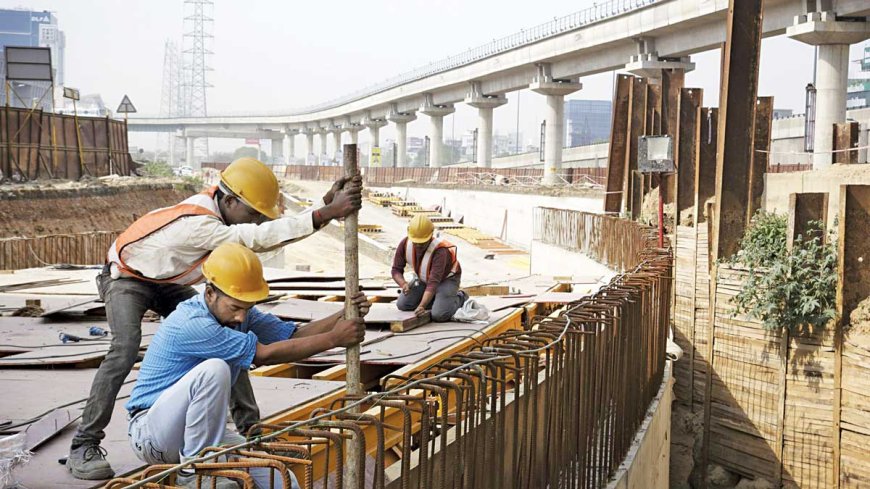INCLUSIVE GROWTH
Government’s focus on the infrastructure and construction sectors is expected to drive the demand for heavy equipment, which will in turn drive the growth of for components, accessories, spares and hardware segments. Prajakta Karnik speaks to industry experts about the

Government’s focus on the infrastructure and construction sectors is expected to drive the demand for heavy equipment, which will in turn drive the growth of for components, accessories, spares and hardware segments. Prajakta Karnik speaks to industry experts about the latest trends in the sector.
India is undoubtedly one of the fastest growing economies in the world and the most preferred destination for investments. However, for long, India’s growth was hinged largely on imports. India was importing not only raw material and machines, but also technology. This resulted in higher capital outflow. But thanks to the initiatives taken by the government in the last couple of years, especially during the Covid pandemic, there is a greater emphasis on becoming self-reliant.
The urgent need to become self-reliant came to the fore largely due to the geopolitical scenario and the Covid pandemic which adversely impacted trade due to movement restrictions. However, the foundation of becoming self-reliant was laid in 2014 when the government announced its Make in India programme to give a boost to the domestic manufacturing sector, the backbone of economic growth of the country. These initiatives are crucial especially at a time when India has planned aggressive and ambitious projects like Bharatmala, Sagarmala, Gati Shakti Plan, Smart Cities, etc. to create world-class infrastructure. These projects are expected to give a boost to the construction equipment industry.
The construction equipment industry has also undergone a major overhaul in the last couple of years with the introduction of newer technologies and the mandatory requirements of meeting emission norms. There is a lot of emphasis by original equipment manufacturers on “green” machines that are more energy efficient with higher performance and efficiency. This has forced construction equipment component manufacturers also to adopt newer technologies and to innovate their product offerings and services to meet the demands of OEMs.
Manufacturers are adopting smart manufacturing processes to improve efficiency. Smart manufacturing means bringing the elements of smart technology – sensing inputs, computing power, always-on connectivity and artificial intelligence, among others. As there is a lot of emphasis on localisation and to create more jobs in India, many international firms, especially organised component manufacturers, have set up their base in India and have localised their offerings while meeting the global standards.
Digital Disruption & Make In India
The demand for industrial automation and robotics in manufacturing is mainly driven by the automotive and general industries like rubber, plastics, metals, and electrical & electronics segments. The usage of low and mid-level automation in the Indian manufacturing industry is the driver for growth in the industrial robot space in India.
 “Implementation of Industry 4.0 for ‘Make in India’ and ‘Atmanirbhar Bharat’ in the manufacturing sector is being promoted by Indian government since it helps provides a steady growth. As we all know Industry 4.0 is characterized by several technologies that come together to digitize the shop floor. With these technological advancements, organizationscan leverage data from multiple fonts, like connected machines, equipment, sensors, actuators and many others to renovate their brownfield plants and processes to achieve efficiency at several levels,” Saurabh Kulkarni, Mobile Automation Expert, B&R Industrial Automation, India.
“Implementation of Industry 4.0 for ‘Make in India’ and ‘Atmanirbhar Bharat’ in the manufacturing sector is being promoted by Indian government since it helps provides a steady growth. As we all know Industry 4.0 is characterized by several technologies that come together to digitize the shop floor. With these technological advancements, organizationscan leverage data from multiple fonts, like connected machines, equipment, sensors, actuators and many others to renovate their brownfield plants and processes to achieve efficiency at several levels,” Saurabh Kulkarni, Mobile Automation Expert, B&R Industrial Automation, India.
 “Make in India is one of the best Initiatives for the country and it is shaping up – though it has taken more than the predicted tune still will help the industry & manifesting GDP growth. Digital transformation is the present industrial revolution, some famously call it as Industry 4.0. The rise of informed customers and innovative technologies have made the manufacturing industry an example of how effective modern operational strategies can reshape the overall operations of an organization stated,” Dhanraj Kalbhor, Vice President – Operations, Nord Drivesystems.
“Make in India is one of the best Initiatives for the country and it is shaping up – though it has taken more than the predicted tune still will help the industry & manifesting GDP growth. Digital transformation is the present industrial revolution, some famously call it as Industry 4.0. The rise of informed customers and innovative technologies have made the manufacturing industry an example of how effective modern operational strategies can reshape the overall operations of an organization stated,” Dhanraj Kalbhor, Vice President – Operations, Nord Drivesystems.
He noted that the tools of technological disruption like IIoT helps the manufacturing industry to reduce the consumption of man & machine resources but with increased output without compromising on quality or if needed even enhancing it keeping overall production costs well in control.
“With digital technology being increasingly absorbed across industrial sectors, now we can predict product manufacturing & delivery lead time with higher accuracies. The innovative tools thus help in increasing productivity with operational efficiency and improved supply chain management systems,” he added.
 According to Meena Goel, Head Business Development, Polyhose Group with the rise in government allocation through the Pradhan Mantri Gram Sadak Yojana (PMGSY), a large growth has taken place in rural road connectivity and is increasing. The recently announced Rs 100 lakh crore, Gati Shakti plan will be a boost when implemented, along with the high-speed expressways which are under construction., and all this will push demand.
According to Meena Goel, Head Business Development, Polyhose Group with the rise in government allocation through the Pradhan Mantri Gram Sadak Yojana (PMGSY), a large growth has taken place in rural road connectivity and is increasing. The recently announced Rs 100 lakh crore, Gati Shakti plan will be a boost when implemented, along with the high-speed expressways which are under construction., and all this will push demand.
“Industry 5.0 is the buzz word, and our Group acquisitions globally indicate that it may not be enough to merely automate tasks or digitize processes. We need to combine technology and human creativity,” she added.
 Rohit Saboo, President & Chief Executive Officer, National Engineering Industries noted that with the current wave of digitalisation, we are making constant strides towards digitising our supply chains, optimising our inventory and predict machine breakdowns using data analytics.
Rohit Saboo, President & Chief Executive Officer, National Engineering Industries noted that with the current wave of digitalisation, we are making constant strides towards digitising our supply chains, optimising our inventory and predict machine breakdowns using data analytics.
“We are making investments towards technology and aim to fully digitise our manufacturing & non manufacturing operations in the coming years. Going forward, every business will be a digital business. Both brownfield and greenfield manufacturing are adopting digital manufacturing and industry 4.0. All functions within an organization have a need now to move to digital and are adopting various technologies. Manufacturing is moving to a connected factory state,” he added.
PLI Scheme
 The government continues to extend its support towards the vision of ‘Aatmanirbhar Bharat’, creating an influx of domestic trade, spearheading economic revival for the country post Covid-19.
The government continues to extend its support towards the vision of ‘Aatmanirbhar Bharat’, creating an influx of domestic trade, spearheading economic revival for the country post Covid-19.
“The PLI Scheme is bound to help propel the country as the land of opportunities, and give a boost to the domestic manufacturing sector, encouraging upcoming MSMEs to grow and nurturing their potential. The PLI Scheme will lead to crores of fresh investments and FDI, while generating lakhs of job opportunities. Directly playing a role in the increase of India’s share in global trade, the government’s sizeable incentives under the scheme will actively revive segments of the economy that have been severely hit by the pandemic,” opined Rajiv Poddar, Joint Managing Director, Balkrishna Industries.
 Echoing similar views, Farrokh Cooper, Chairman & Managing Director, Cooper Corporation said the goal of the PLI scheme is to make local manufacturing globally competitive and to create global manufacturing Champions. “It is a wonderful opportunity for manufacturers since it works as a growth accelerator, boosting local production and increasing domestic capacity and exports. With an outlay of Rs 26,058 cr., the scheme aims to draw investments of over Rs 42,500 cr. by 2026 and incremental production of over Rs 2.3 lakh cr. for vehicle and part makers,” he added.
Echoing similar views, Farrokh Cooper, Chairman & Managing Director, Cooper Corporation said the goal of the PLI scheme is to make local manufacturing globally competitive and to create global manufacturing Champions. “It is a wonderful opportunity for manufacturers since it works as a growth accelerator, boosting local production and increasing domestic capacity and exports. With an outlay of Rs 26,058 cr., the scheme aims to draw investments of over Rs 42,500 cr. by 2026 and incremental production of over Rs 2.3 lakh cr. for vehicle and part makers,” he added.
Green Initiatives
 With the increasing awareness of carbon emissions, the government has taken several initiatives to reduce India’s carbon footprint by 30-35 % and is also focusing on adopting alternate fuel sources.
With the increasing awareness of carbon emissions, the government has taken several initiatives to reduce India’s carbon footprint by 30-35 % and is also focusing on adopting alternate fuel sources.
According to Dr. Daya Shukla, Senior Director – R&D / Technology, Raj Petro, the emphasis of greener requirements has driven the development of ester based lubricant and biodegradable products. “Newer developments are visibly seen in the direction of long drain and cost-effective synthetic fluids. With a prominent improvement of consumer knowledge towards fluids like grease, coolant & brake fluids are seen the industry to develop products offering longer mileage and life,” he added.
 Mandar Deo, Vice President, Power Systems, Cummins India opined that for the India market– alternative sources of energy to diesel power, are gaining traction in the automotive, industrial and back-up power market, addressing the niche market demand. But, the diesel genset market remains the key product in the back-up power segment in the foreseeable future, owing to the ease of availability, maintenance, and familiarity with the products and reducing run hours.
Mandar Deo, Vice President, Power Systems, Cummins India opined that for the India market– alternative sources of energy to diesel power, are gaining traction in the automotive, industrial and back-up power market, addressing the niche market demand. But, the diesel genset market remains the key product in the back-up power segment in the foreseeable future, owing to the ease of availability, maintenance, and familiarity with the products and reducing run hours.
“With continuous improvements being made in the products –enhancing fuel efficiency, footprint reduction, powered by remote monitoring devices and cleaner exhaust – the diesel gensets remain one of the largely opted products for back-up power for key sectors. The diesel genset segmentis gearing up for the next emission norms – CPCBIV+ – driving environmentally conscious products. These norms are more stringent than the global tier 4F norms for certain nodes, reducing the CO, NOx, and PM nearly 90% from the previous emission guidelines,” he added.
Challenges
 According to Anup Nair, Managing Director – India & South Asia, Martin Engineering said, “The commodity prices are at an all-time high. Metals like steel, aluminium, copper and other ingredients viz. rubber, polyurethane have all gone up in several folds. The logistics costs have also gone up due to the increase in fuel prices. The international freight rates and scarcity of containers also is a challenge. Though we are offsetting some portion of this by increase in prices, it is a challenge and creates uncertainty of our margins.
According to Anup Nair, Managing Director – India & South Asia, Martin Engineering said, “The commodity prices are at an all-time high. Metals like steel, aluminium, copper and other ingredients viz. rubber, polyurethane have all gone up in several folds. The logistics costs have also gone up due to the increase in fuel prices. The international freight rates and scarcity of containers also is a challenge. Though we are offsetting some portion of this by increase in prices, it is a challenge and creates uncertainty of our margins.
Way Forward
India is one of the largest construction equipment markets in the world. The government’s intense focus on the infrastructure sector is further expected to drive the growth of the construction equipment industry. This will drive the demand for component manufacturers as well.

Hits: 51








